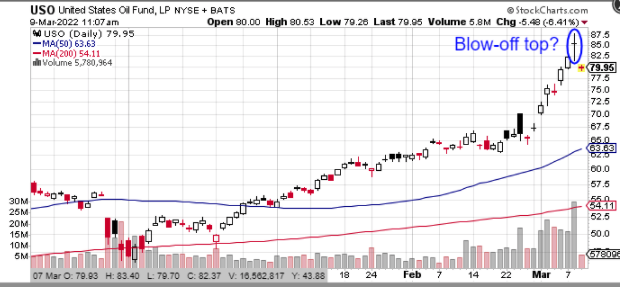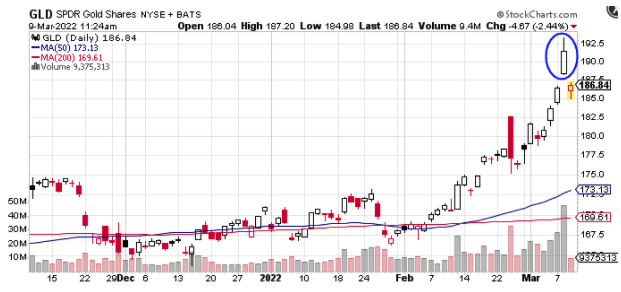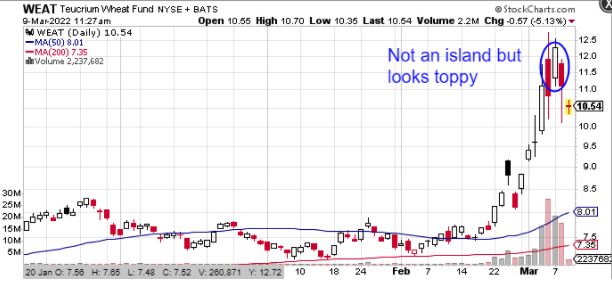
Credit Spreads: A Useful Strategy in Volatile Markets
By: Steve Smith
Last week, I started a mini-series on the various aspects of options trading. In the first few articles, I addressed “Calculating Returns” and “Setting up the Proper Risk/Reward.” Today’s focus will be on analyzing profit and probability.
However, first I want to refer to yesterday’s article on “The Three Things I’m Looking For to End the Bear Market” to point out an item that possibly occurred today. Namely, the blow-off top in the commodity complex suggests inflation won’t spiral uncontrollably.
Here are 3 key commodities that are leaving bearish islands on the charts. :
First, oil as measured by the United States Oil ETF (USO). Oil and energy is a central issue surrounding the control of Ukraine and a pullback suggests traders believe some form of diplomatic resolution could be achieved.

Next up is gold, as tracked by the SPDR Gold Shares (GLD); a reversal here suggests that panic into a safe haven is subsiding. This is somewhat confirmed by selling in U.S. Treasuries today.

Last is wheat via the Teucrium Wheat Fund (WEAT). While this isn’t a true island reversal, it does look a bit toppy. Wheat might be the most important commodity to get under control to avoid global food shortages which would lead to more unrest.

It’s still early in the day, but I’ll be keeping an eye on these and the Options360 Concierge Trading Service might start pricing out some bearish positions in commodities and related names such as Deere (DE), Mosaic (MOS), and Nucor Mining (NUE). And more importantly, checking this box on my three things has me building a buy list that includes some cybersecurity names and retailers.
Now, back to our regularly scheduled program; exploring some concepts and applications of trading options. In this installment, I’ll cover the use of credit spreads — a useful volatile market strategy — which Options360 has been using more frequently in the past weeks. There are some positions that you don’t need to take many actions on, with the exception of exhibiting patience.
I’m talking about positions in which a spread is sold for a credit. If the value of the options declines, a profit can be realized. The profit is limited to the sale price or premium collected. The maximum profit would be realized if the option expires worthless.
Typically, credit positions involve puts, calls, or a combination of both that have strikes that are out-of-the-money. Meaning, the options have no intrinsic value; entirely comprised of premium. In this sense, the seller, or options “writer” is acting like an insurance company; you collect the premium but also assume the risk of making a large payout or loss; if there’s an adverse event.
To offset this inherently asymmetric risk/reward profile, we need to create a situation that has a high probability of success and ensures we’re collecting enough premium for the risk assumed.
The most important way we limit and manage our options trading risk is to never sell or short options naked. That is to always use some form of a spread. A typical credit spread involves selling a put or call and then buying a further out-of-the money put or call for a lower price.
A basic put credit spread example in Apple (AAPL) would be with shares trading $160 selling the $155 put for $3.00 a contract and buying the $155 put for $1.40 a contract.
That’s a $1.60 net credit. If Apple shares are above $125 on the expiration, all options expire worthless and the $1.60 maximum profit would be realized. On the other hand, if shares sink below $120, the maximum loss of $3.40 would be incurred.
So, why would someone establish a position that can only make $1.60 but lose $3.60? Because even if you were moderately wrong about your bullish outlook, and even Apple shares declined by up to $5 or 3% to $155, you could still realize the maximum profit. Compare this to buying a call option with the 160 strike, which would currently cost $4.50 a contract. In this case, you need shares of Apple to rise an additional $$9.50 or 6% or be at $169.50 at expiration just to break even.
Obviously, the credit spread position has a much higher probability of achieving a profit. If this were baseball, credit spreads would allow you to be the batter to the market’s pitcher, forcing it to do all the work by throwing strike after strike.
Tailwinds of Time and Volatility
Positions primarily benefitted from time decay and an implied volatility decline. This makes them best suited for sideways or range-bound markets; ones that exhibit a reliably-steady trend, or situations where volatility levels have elevated to levels that are unlikely to persist.
To set up a position with a high profitability probability and acceptable risk/reward profile, I use two basic parameters.
I want at least 75% probability of a profit; that means choosing the inside or short strikes that have below 25% probability of expiring in the money. While many option chains will provide probabilities of expiration. A basic rule of thumb is to look at delta. I’m using strikes with a 0.20 delta, meaning they have only a 20% chance of being in the money on expiration.
I also want to achieve a 20% return on my risk capital. That means there must be enough premium to generate sufficient income while marinating the limited risk of a spread.
While I have the probability of profit in my favor, I want to further manage risk. I use the basic rule of thumb that I should close positions once either 75% of profit has been realized, or a 75% loss was incurred.
For instance, in my above Apple example, if shares quickly rallied above $170, the put spread value might decline to 40 cents way before the March expiration. At this point, I’d look to close the position for a profit.
For an adverse move such as what we’re experiencing in the SPY condor if the value of the iron condor climbs to $2.02, I’d close the position.
You can create a sliding scale along a time frame. For example, if a 50% profit could be realized within a matter of days, it may make sense to close the position. If you’re suddenly facing a 50% loss, clearly something in your thesis of range-bound or declining volatility environment was wrong, and it may be best to just vacate.
However, no matter the time frame, if an option you’ve sold short has declined to below $0.10 a contract, then buy it back and cover yourself. At that point, the risk/reward becomes too asymmetrical. Don’t try to squeeze out the last dime of premium, it would cost you multiple dollars.
To sum up this series on profit and profitability, I’ll say this: it’s important to understand how risk is measured, knowing how to identify the fat pitches, but also having the skills and patience to occasionally take a walk. Keep these things in mind, and your options trading will be smoother and more manageable.
